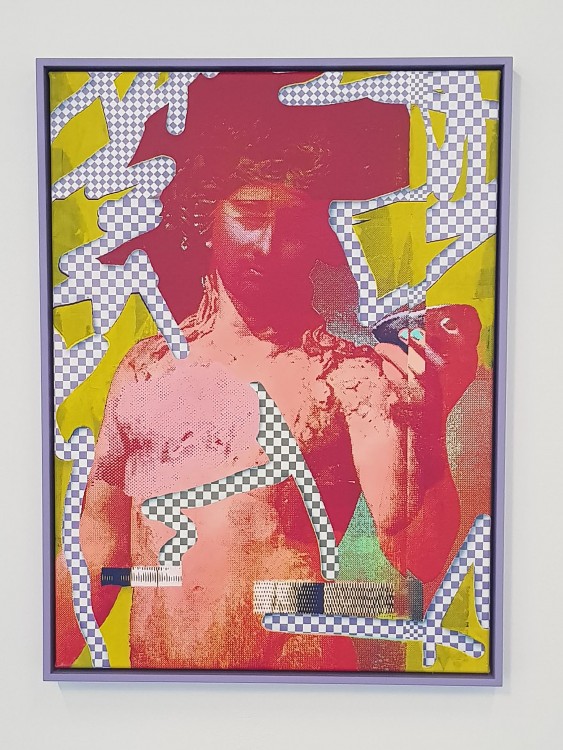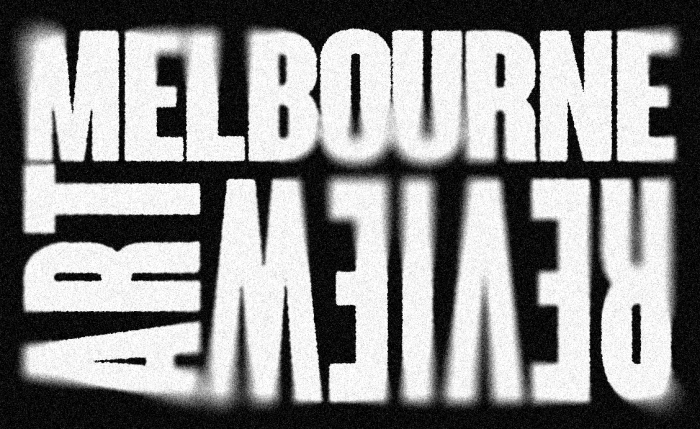Share this:
Virtual Inanity
17 July 2018 Comment
Kings Artist Run Initiative segues off Bourke Street and is calm, as the traffic, hums undisturbed outside. Its narrow stairwell, easily missed by a casual eye, feels like an ascension from the chaos of the city and into the focused minimalism of a gallery space. Ingmar Apinis’ exhibition ‘Virtual Inanity’ addresses the stigma of art mediums (specifically art created digitally) in his recontextualization of what he describes as. “tired internet tropes.” By this Ingmar is alluding to the common criticisms plaguing digital art since its inception; its two dimensionality, prioritization of style over substance and borrowed, reworked content. In his work, monochromatic elements in varying pastel shades are arranged haphazard on the canvas, segmented, abstracted figures often the focal point. Despite resembling digital images aesthetically, the pieces themselves are created physically, using screen prints, acrylic paints and aerosols to translate the subject matter and style into a different medium. Close inspection reveals the texture of paint and imperfect prints, mistakes are not sporadic but deliberate; an intentional identifier of the works form. There is something vaguely Duchampian about the work, Ingmar has gifted digital art the prestige traditional mediums hold over many casual viewers. The biased viewer is now forced to look objectively at work they may otherwise dismiss upon medium alone.
‘Back us up’ (one of my favourites of the series) presents a somber man staring at a rock. An arbitrary image but aesthetic significance, just as Marilyn Munro or Soup was to Warhol’s work. These figures don’t mean anything, they don’t have to, instead they are in of themselves an art element as opposed to art, comparable to visible brush strokes or pattern. The pieces are heavily reminiscent of Pop Art, no surprise really, both were established in the sixties and aside from their obvious reliance on one another, face (then and now) many of the same biases. (They’re perceived two dimensionality both literal and conceptual for instance.) Digital Art -as with most relatively new artistic mediums, has a faint negative stigma. In the age of streamlined electronics, ease of use does nothing to dissuade those who would mutter or proclaim, “I could do that!” when faced with such pieces. Though digital creators are but new victims of a bias against ‘easy mediums’ perpetuated since the invention of the camera. (If not earlier.)
The figures in the pieces are exclusively Grecian. Classical representations lost to time as perhaps traditional mediums may soon be. Ingmar’s artist statement refers to “The outdated technology of the artists touch.” A macabre preposition and though I fundamentally disagree with it, it is no less provocative. The idealized male and androgynous nudes of antiquity serve also to highlight the imperfections embraced by the artist. Otherwise classically perfect bodies are defaced with checkered patterns and overlapping images, either imperfections or improvements, depending on your aesthetic preference.
The works hyper-fixation on itself is telling of how we view and create art and the broader systemic issues within the community. Is this work better because it was created physically? The fact that the question was asked, though seemingly inane, makes the exhibit worth a visit. One thought persists after my viewing however, are ‘mistakes’ as deserving of praise or as beneficial to art as perfections?
Words by John Thompson
"Back Us Up"


